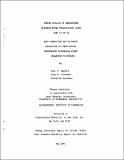| dc.contributor.author | Sanders, Joel Vincent | |
| dc.contributor.author | Glicksman, Leon R. | |
| dc.contributor.author | Rohsenow, Warren Max | |
| dc.date.accessioned | 2005-09-15T14:32:19Z | |
| dc.date.available | 2005-09-15T14:32:19Z | |
| dc.date.issued | 1974 | |
| dc.identifier.uri | http://hdl.handle.net/1721.1/27248 | |
| dc.description | Forced cooling of underground electric power transmission lines, pt.2 | en |
| dc.description.abstract | Forced-cooled systems for oil-filled pipe-type cable circuits have
recently been considered. In such systems the conduction resistance
through the paper insulation of the cables is the limiting thermal resistance.
Assuming bilateral symmetry, steady-state conditions, and two-dimensional
heat transfer, a FORTRAN IV computer program was written to solve the heat
conduction problem in the cable insulation for arbitrary configurations
of a three-cable system.
For a steel pipe, a cable system is most susceptible to overheating
in the equilateral configuration with the three cables touching.
Proximity effects are very significant in forced cooling, especially
when cables are not provided with a copper tape under the insulation moisture
seal assembly, accounting for as much as 21% of the total oil temperature
rise between refrigeration stations. This figure, however, is reduced to
8% when 0.005 inch thick copper tape is present. | en |
| dc.description.sponsorship | Consolidated Edison Co. of New York | en |
| dc.format.extent | 8574764 bytes | |
| dc.format.mimetype | application/pdf | |
| dc.language.iso | en_US | en |
| dc.publisher | MIT Energy Lab | en |
| dc.relation.ispartofseries | MIT-EL | en |
| dc.relation.ispartofseries | 74-004 | en |
| dc.subject | Underground electric lines -- Cooling | en |
| dc.subject | Heat -- Conduction | en |
| dc.subject | Electric cables | en |
| dc.subject | Electric insulators and insulation | en |
| dc.title | Heat conduction in the cable insulation of force-cooled underground electrical power transmission systems | en |
| dc.type | Technical Report | en |
